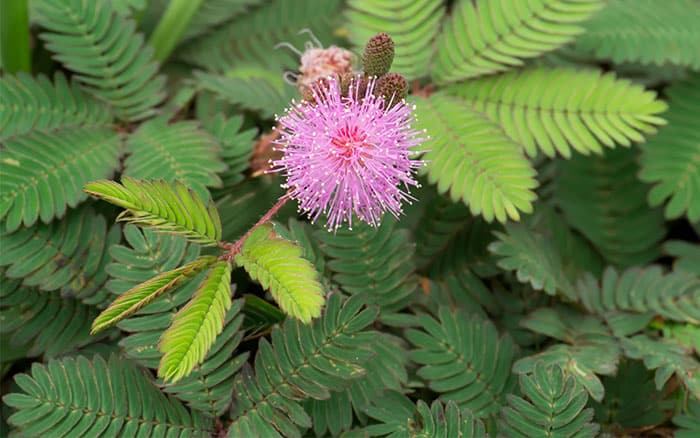Guardians Of The Galaxy brought us one of our favourite characters, Groot—the walking talking plant with an attitude.
He may seem like a far-fetched character with incredible abilities, but, actually, you may be amazed to hear that a lot of his “superpowers” are rooted in science!
Here we look at Groot’s extraordinary qualities and uncover which ones we can find in the real biosphere…
Groot can move
Now plants can’t just get up and walk around… you might say it’s one of their defining characteristics.
‘These roots weren’t made for walking.’
However, you may be surprised at just how limber some plants can be.
Unfortunately, it looks like the so called ‘Walking Palms’ of Latin America, whom tour guides have been saying for years uses their unusual root structure to slowly move towards the sunlight, is probably false.
However there are some other interesting specimens…

The leaves of the Mimosa pudica, or ‘touch-me-not’, shrink and fold away when touched with beautiful efficiency.
This has probably evolved as a way to defend itself from damage and scare away insects.
And we’ve all seen a venus fly trap in action as it snaps closed on an unsuspecting fly…
And of course, though they remain rooted to the ground, many plants lean and stretch towards the light, climb up walls and objects, and often have incredible methods for sending their seeds far and wide.

Groot regenerates
Groot has the handy ability to regrow limbs lost in battle. In fact, when Groot is destroyed he can be completely regrown from a tiny branch.

This is actually a property of most of the plant world to some degree, and it makes them incredibly resilient. You can take a cutting from almost any plant, put it in some water or wet soil, and watch new roots form! You can go and chop all of the branches off of a tree, but the chances are it will just start growing new ones and carry right on. You can even take the root end of your celery or spring onions (and many other veggies), pop it in a little water, and watch it regrow right on your windowsill.
Groot communicates
Now this is where it gets a bit freaky. Groot may be restricted to a single phrase or two, but we wouldn’t expect real plants to speak at all.
Well, shockingly, it turns out that many plants can actually communicate! How do they do it? A number of ways.
Some plants send electrical messages through their roots to each other. Others release gases into the air which other plants can ‘smell’ and react to.

One of the most fantastic and unexpected ways they do it is by sending chemical signals through a network of fungi whose tendrils spread through the forest floor (what the researchers like to call the Wood Wide Web).
So… what do they talk about?
It turns out that they use these signals to warn each other of disease, drought and predators. For instance when a willow tree is attacked by insects it pumps a chemical into its leaves that makes them taste horrible; it then releases a gas into the air that tells all of the local willows to do the same. Acacia trees in Africa take the same approach when giraffes begin to eat their leaves.
Groot can call in the cavalry

Groot has the ability to get other plants in the area to do his bidding and help him out when he’s in a tight squeeze.
But some real plants can do more than that! These plants, when being attacked by certain insects, can actually call in other insects who prey on their attackers!
For instance, when wild maize (corn) is attacked by caterpillars it releases a pheromone that attracts a type of wasp that lays its eggs in those caterpillars and kills them.
Disgusting, but effective.
Some plants can even distinguish between different attackers by their saliva and call in different predators depending on the target! How’s that for precision weaponry.
Groot is fire resistant
A handy trait in a fiery action battle, but not something we usually associate with trees. Understandable, considering they are literally the things we burn when we want to make a fire!
The Australian eucalyptus flies in the face of that stereotype. In fact, it is a veritable pyromaniac.

Not only is it immune to forest fires, it downright advocates them! With a hidden stem deep inside its trunk, ready to spring out once the fire clears, it is designed to be the last tree standing.
But more than that, it actually produces an oil so flammable that the tree can actually explode if it catches fire. The leaves are so full of tree napalm that insects and fungi wont digest them, making a tinderbox out of the forest floor.
As if that wasn’t enough, it also releases the oil as a flammable gas cloud, just waiting for a lightening strike or stray cigarette!
Groot cares for his friends

Groot shows his compassion in the final scenes of Guardians 1 when he sacrifices himself for his friends, changing his trademark phrase to ‘We are Groot’ in a heart-wrenching moment.
Our everyday plants may not be able to do it with such style, but it turns out that they can and do help each other – especially their relatives.
Some plants can transfer nutrients through intertwining roots to their neighbouring relatives that are struggling or damaged. Tree stumps have been found in forests with no leaves, which should mean suffocation and death for a tree since they can’t process sunlight or carbon dioxide. But, incredibly, the trees surrounding the stumps have been sacrificing some of their own nutrients, keeping the stump alive for hundreds of years!
So there you have it. You don’t have to search the galaxy to find extraordinary plant life – there’s plenty here on earth.

An eye opener. Now I can count on my banana plants to defend themselves.